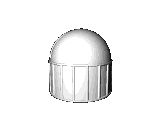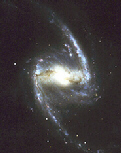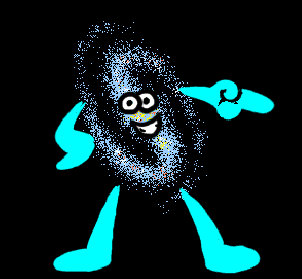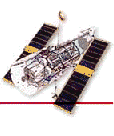A galaxy is made of billions of stars, dust, and gas all held together
by gravity. Galaxies are scattered throughout the Universe. They vary greatly in size and
shape. Not all galaxies look alike.
This is a galaxy.
Did you notice that these galaxy pictures don't look alike?
When telescopes led to the discovery of galaxies, astronomers observed many differences. In 1926, an astronomer named Edwin Hubble decided to classify the galaxies, grouping them according to some logical scheme. He could have classified them according to color, because galaxies are different colors. You can see many different colored galaxies in the Hubble Deep Field image.
After considering different schemes, he decided to arrange or group them by shapes. He would classify them according to the way they looked. In science, the study of something according to its form or structure is called "morphology".g Let's consider the three galaxies we saw earlier. They are typical of the three main types of galaxies that Hubble classified.
Hubble called the second type of galaxy you saw a spiral galaxy. It reminded him of a pinwheel or whirlpool. He used the letter "S" to stand for spiral galaxies.
The third type of galaxy reminded Hubble of a spiral with a solid bar across the center. He called it a barred spiral galaxy. He used the letters "SB" to stand for barred spirals.
To show the relationship of the galactic shapes, Edwin Hubble arranged the main types of galaxies and the sub-types into a chart that has come to be called "The Tuning Fork Diagram". The Hubble "Tuning Fork Diagram" is the simplest way to classify galaxies. When you look at a picture of a galaxy, and try to classify it, you are trying to place it on the diagram where it belongs.
NOTE: You must have a java-enabled browser in order for the next page to work. If your browser does not work with java applets, Click here.
Read the summary written below the picture to see if you were correct! Use the Back button at the top of your Web Browser to return here when you have finished your visit to Space Telescope Science Institute. Space Telescope Science Institute
Use the Back button at the top of your Web Browser to return here when you have finished your visit to Space Telescope Science Institute.
Now that you have had practice at classifying galaxies according to shape, you are ready to take the challenge of becoming a member of the Hubble Deep Field Academy. Remember this picture? Use this link to the "Cosmic Classifier" to test your new skill at classifying galaxies in the Hubble Deep Field image. Want to find out more about Edwin Hubble's Classification system? Click on the obsrvatory dome!  Are you ready to go galaxy
hopping on your own? Explore these astronomy links!
Are you ready to go galaxy
hopping on your own? Explore these astronomy links!
Copyright © 2001 The Regents of the University of California |


 This
is also a galaxy
This
is also a galaxy  He could have classified them according to size, calling small galaxies "dwarf
galaxies" and calling large galaxies "massive galaxies".
He could have classified them according to size, calling small galaxies "dwarf
galaxies" and calling large galaxies "massive galaxies". 
 The Hubble
Telescope has looked far into space and discovered many galaxies. Travel to the Hubble
Space Telescope Institute to look at an image of a newly discovered galaxy. See if you can
classify it by its shape.
The Hubble
Telescope has looked far into space and discovered many galaxies. Travel to the Hubble
Space Telescope Institute to look at an image of a newly discovered galaxy. See if you can
classify it by its shape. 

